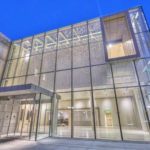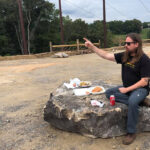Jason Sandford
Jason Sandford is a reporter, writer, blogger and photographer interested in all things Asheville.
Mike Belleme is one of Asheville’s premier photographers. He works regularly for New York Times, he is a documentary photographer and he shoots portraits. That’s just what I know off the top of my head – I’m sure there’s much more.
Belleme will open a new photography exhibition with a 7 p.m. reception at Satellite Gallery in downtown Asheville. He’ll have a series of photos on display that he shot over six years, images that document the back-to-the-land lifestyle of Wildroots, a small group of modern homesteaders living in rural Western North Carolina. Members of the group practice “earth skills” such as foraging and woodworking to live without electricity or other modern conveniences.
I asked Belleme to tell me a little more about his experience with Wildroots – how he connected with them and what he admires about them. Here’s what he wrote back:
Q: Can you tell me a little bit more about Wildroots? What is this group? Why are they living the way they are?
Belleme: People come and go from Wildroots all the time for their own reasons and it’s hard to make any blanket statements about the purpose of Wildroots or why people choose to live there, because it’s different for everyone.
The couple that has been there for the longest is Tod and Talia, they have been there ten years and are the main focus of most of the work. They moved to Wildroots in the first few years of it’s existence. They were living in California, where Tod was in the process of getting a master’s degree in engineering from UC Davis focusing on alternative energy. He was creating fuel cells for electric cars and was poised to enter a lucrative career in the field. As he learned more about the industry and rubbed elbows with some of the big players in the automotive industry leading their green initiatives, Tod became completely disillusioned by the whole “environmentally conscious” industry. He was finding that it was more about making money than saving the earth, and in many ways it was still contributing to the destruction of the planet. He and Talia started hearing about primitive skills and they were also predicting an economic collapse and thought it could cripple civilization. They wanted to learn how to take care of themselves if the trucks stopped pulling up to the grocery store. So when they heard about Wildroots, they sold their house at a huge gain because it was the height of the housing bubble, and they left California for the mountains of Western North Carolina.
Q: How did you connect with them?
Belleme: I heard about Wildroots from a friend who had a friend living there. I was able to get ahold of him and ask if I could come out for a visit. My first trip there, I didn’t bring a camera, just told them I was interested in learning about their way of life and doing some documenting. They agreed, so I came back for my first 10-day stay in the fall of 2010. I’ve been going back ever since and developed a strong relationship with them.
Q: Are they in Western NC?
Belleme: Yes. I’m not allowed to say any more than that. This is because, obviously, their housing is not up to code, so they are in danger of completely loosing Wildroots and their way of life if they got unwanted attention. They do, however, want people to know about them and that way of life, so if they are interested in living that way, they can come. So that’s why they let me come shoot there.
Q: Why did you decide to follow them?
Belleme: It was a no-brainer. In my first 10-day stay there, it became very clear to me that not only was this going to be a big long-term project for me, but it was going to be life-changing.
Q: What about them captivates you? Do you admire the Wildroots lifestyle? How has it affected they way you live your life now?
Belleme: I spend very little of my time at Wildroots shooting. Mostly I’m helping on building projects, hauling water, gathering food, cutting firewood, etc. I work very hard when I’m there and learn an incredible amount with each visit. Tod has become a major mentor of mine. I started learning about plants and trees and their properties and then got into woodworking all as a result of spending time there. Soon my girlfriend, Kristen and I found ourselves moving out of town into a little treehouse in the woods and were able to incorporate some of what I was learning at Wildroots in our daily lives. We were foraging for wild foods, as well as gardening there, and using a mix of primitive and more modern techniques for home improvement projects.
I am far from being ready to fully embrace the Wildroots way of life. I’m nowhere near being at the point of wanting to distance myself from society, and I’m way to lazy to make a friction fire every day to cook over. However, getting their perspective over the years has been very eye opening, and I enjoy the few aspects of the lifestyle that I am still able to work into my life. I’m inspired by them. To be clear, though: they are not trying to save the world. They are just trying to carve out some amount of happiness on the fringes of society. They have given up on society and don’t see any point in trying to save it. So they just do their thing out in the woods.



























